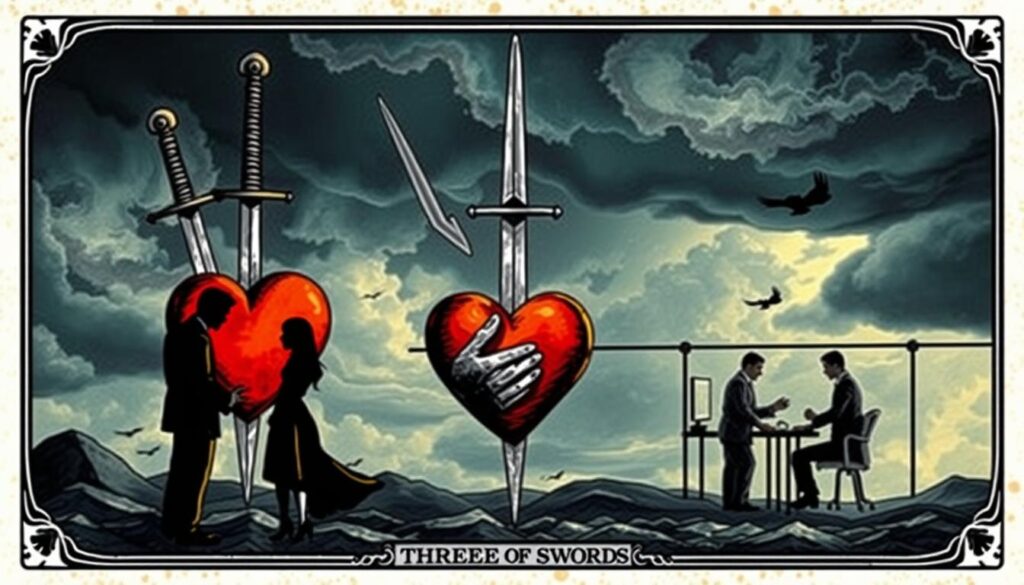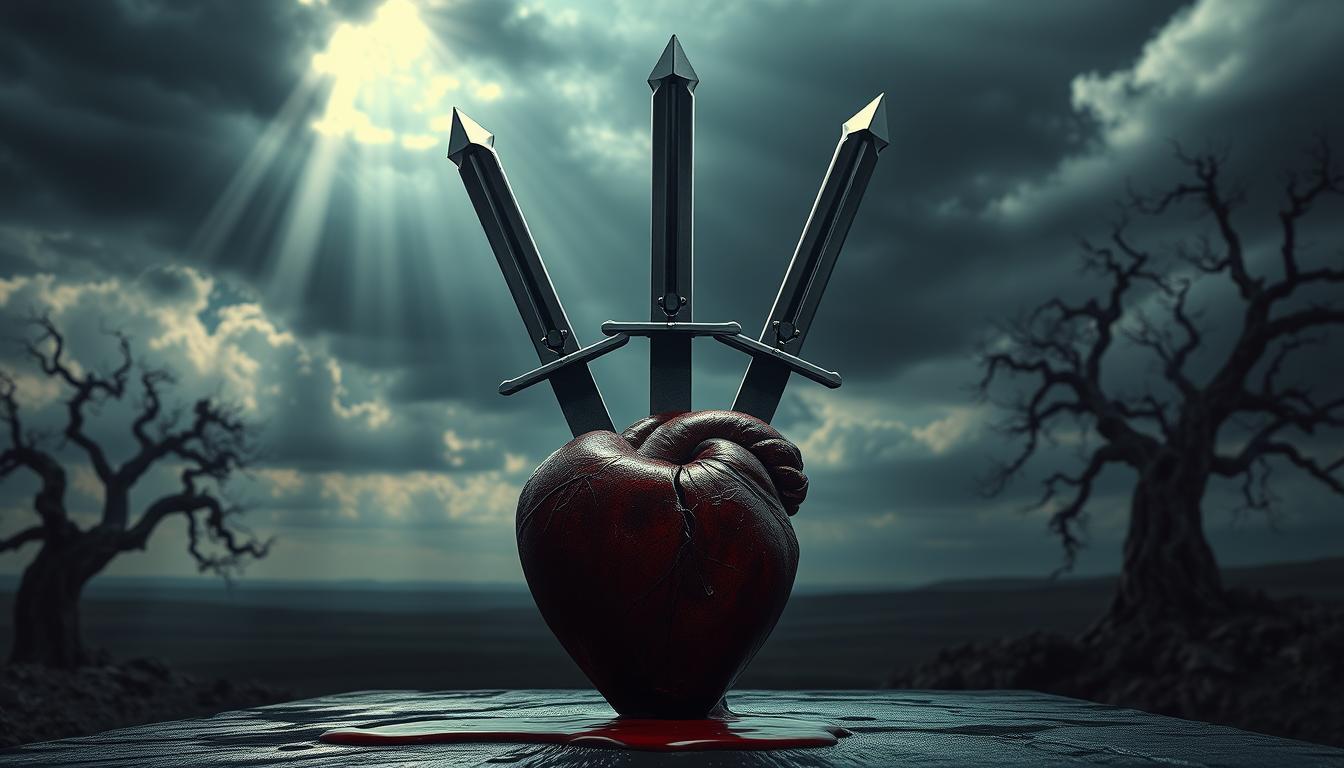Heartbreak cuts deep, but the Three of Swords reminds us that pain can lead to growth. This tarot card shows three blades piercing a heart, surrounded by stormy skies—symbolizing grief, betrayal, or unexpected loss. Though painful, it carries a powerful message: healing comes with time.
When this card appears, it signals emotional upheaval. Yet, it also encourages resilience. The sorrow won’t last forever. Instead, it teaches valuable lessons about strength and self-compassion.
Whether facing a breakup, job loss, or personal disappointment, the Three of Swords highlights the duality of suffering. It’s both destructive and transformative. By embracing the pain, we uncover deeper wisdom.
Key Takeaways
- Represents heartbreak, betrayal, and emotional wounds.
- Symbolizes temporary pain leading to personal growth.
- Encourages resilience and self-compassion.
- Reversed position signals healing and recovery.
- Teaches wisdom through life’s toughest moments.
Understanding the Three of Swords: A Symbol of Heartbreak and Growth
Pain isn’t just suffering—it’s a teacher in disguise. The *Three of Swords* tarot card captures this duality, showing a heart pierced by blades under stormy skies. While its imagery stings, the message is clear: wounds can transform into wisdom.

The Upright Meaning: Pain as a Catalyst
When this card appears upright, it signals a time of emotional release. Suppressing grief only prolongs the hurt. Instead, facing loss head-on avoids stagnation. Pain becomes a catalyst, pushing us to evolve.
Think of a friend’s harsh words or a sudden breakup. These moments feel crushing, yet they teach resilience. As one quote puts it: “Without heartbreak, there would be no knowledge.”
The Visual Symbolism: Clouds, Swords, and Healing
The three swords represent external sources of pain—betrayal, criticism, or life’s unpredictability. Storm clouds? They’re temporary, like emotional turmoil. Rain washes away sorrow, hinting at renewal.
Here’s how to reframe the hurt:
- Journal: Write to process emotions.
- Practice mindfulness: Observe feelings without judgment.
- Seek support: Share the load with trusted friends.
The pierced heart isn’t just a wound—it’s proof you’re strong enough to heal.
How to Process Emotional Pain with the Three of Swords
Grief is not a sign of weakness—it’s the first step toward strength. When this card appears, it urges you to confront raw emotions head-on. Suppressing them only deepens the wound.

Allowing Yourself to Grieve
A good cry isn’t indulgent—it’s necessary. Physical release (like running or dancing) shakes off stagnation. Society often labels vulnerability as failure, but healing begins with honesty.
Try these techniques to release pain:
- Creative outlets: Paint, write, or scream into a pillow.
- Therapy: A safe space to unpack triggers.
- Movement: Yoga or boxing to channel energy.
| Barrier | Solution |
|---|---|
| “Stay strong” mindset | Prioritize self-compassion |
| Fear of judgment | Seek supportive communities |
| Rushing recovery | Honor your timeline |
Shifting Perspective: From Hurt to Wisdom
Criticism—like internet trolls—often reflects others’ emotions, not your worth. Reframe it: “What can this teach me?” A harsh coworker might reveal boundaries you need to set.
Affirmations anchor growth:
“This pain is temporary, but my growth is permanent.”
Every heartbreak carves space for resilience. The storm clouds? They’ll pass.
Navigating Love and Career with the Three of Swords
When emotional storms hit, they test our resilience in love, career, and finances. This card’s piercing imagery mirrors real-life challenges—but also reveals paths to recovery.

Love: Healing After Betrayal or Separation
Heartbreak from infidelity or a breakup leaves deep scars. The Three of Swords urges honesty: suppressed pain delays healing. Start with open conversations to rebuild trust.
For singles, past wounds can block new relationships. Try these steps:
- Journal: Identify patterns from past separation.
- Therapy: Address unresolved triggers.
- Small steps: Date without pressure.
Career: Overcoming Conflict and Disillusionment
Job loss or office tension? This card signals a crossroads. Avoid impulsive resignations—instead, use respectful dialogue to resolve conflicts.
If searching for work:
- Pause: Process the loss before applying.
- Upskill: Take online courses to boost confidence.
- Network: Lean on mentors for referrals.
Finances: Rebuilding After Loss
Divorce or sudden debt? Emotional decisions worsen finances. Create a post-crisis budget, and negotiate payment plans with creditors.
Key actions:
- Track spending: Apps like Mint highlight leaks.
- Legal aid: Consult a lawyer for asset splits.
- Emergency fund: Start small—even $20/week helps.
Remember: The Three of Swords is temporary. Every setback plants seeds for growth.
The Three of Swords Reversed: Forgiveness and Moving Forward
Turning the card upside down reveals a path to renewal. The three swords reversed signals healing—but also warns of buried emotions. It’s a dance between release and resistance.

This position whispers: “Stop replaying their hurtful words.” Negative self-talk—like an inner mean girl—only deepens wounds. Swap “I’m unworthy” for:
“My scars prove I’m strong enough to heal.”
Assess relationships honestly. Ask:
- Reconcile? Only if trust can be rebuilt.
- Walk away? When resentment outweighs peace.
- Financial recovery? Start small—$50/month rebuilds savings.
Beware stagnation. Wallowing keeps you stuck. Try these steps:
- Journal prompt: “What pain am I holding onto, and why?”
- Daily wins: Celebrate tiny progress.
- Boundaries: Say no to energy drainers.
The swords reversed remind us: storms end. Silver linings—like newfound resilience—await.
Conclusion: Embracing the Lessons of the Three of Swords
Resilience grows where pain once lived. This tarot card reminds us that even the deepest wounds fade, leaving wisdom in their wake. Heartbreak, betrayal, or loss—each experience shapes your life in ways joy cannot.
Self-compassion is key. Healing isn’t linear, but every step forward counts. Journaling or daily tarot practices can anchor your progress.
Let the three swords guide you. Their sharp lessons carve paths to strength. When storms come again, you’ll rise—not just survive, but thrive.

